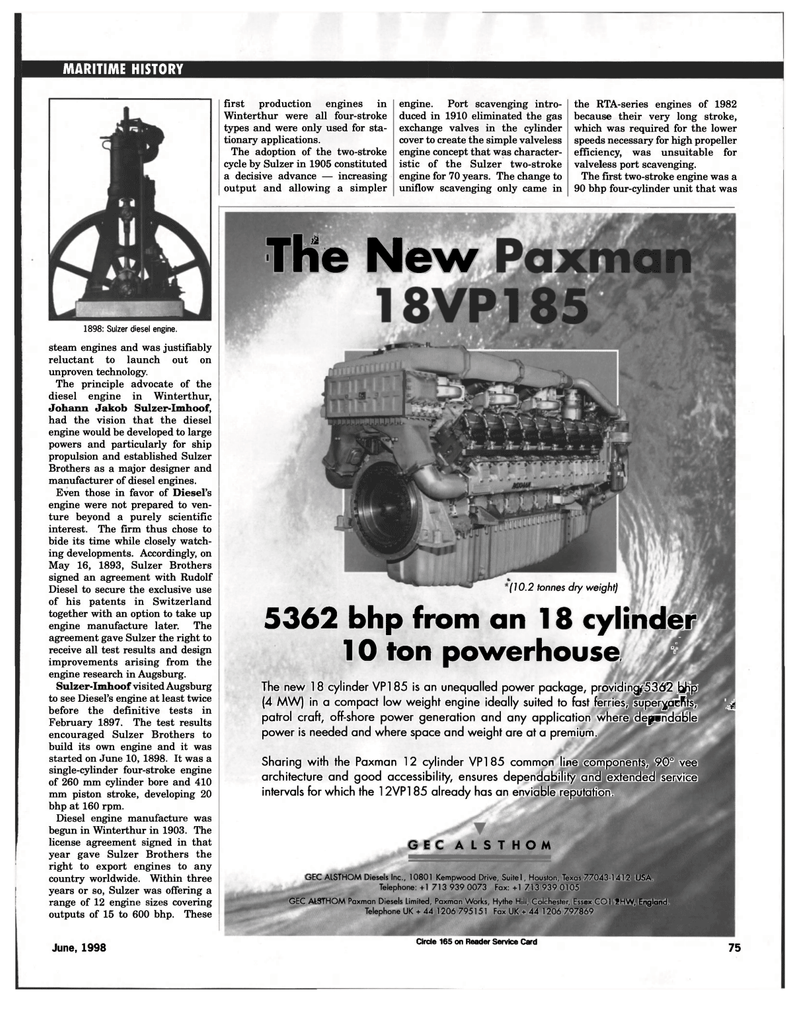
Page 66: of Maritime Reporter Magazine (June 1998)
Read this page in Pdf, Flash or Html5 edition of June 1998 Maritime Reporter Magazine
MARITIME HISTORY 1898: Sulzer diesel engine. steam engines and was justifiably reluctant to launch out on unproven technology.
The principle advocate of the diesel engine in Winterthur,
Johann Jakob Sulzer-Imhoof, had the vision that the diesel engine would be developed to large powers and particularly for ship propulsion and established Sulzer
Brothers as a major designer and manufacturer of diesel engines.
Even those in favor of Diesel's engine were not prepared to ven- ture beyond a purely scientific interest. The firm thus chose to bide its time while closely watch- ing developments. Accordingly, on
May 16, 1893, Sulzer Brothers signed an agreement with Rudolf
Diesel to secure the exclusive use of his patents in Switzerland together with an option to take up engine manufacture later. The agreement gave Sulzer the right to receive all test results and design improvements arising from the engine research in Augsburg.
Sulzer-Imhoof visited Augsburg to see Diesel's engine at least twice before the definitive tests in
February 1897. The test results encouraged Sulzer Brothers to build its own engine and it was started on June 10, 1898. It was a single-cylinder four-stroke engine of 260 mm cylinder bore and 410 mm piston stroke, developing 20 bhp at 160 rpm.
Diesel engine manufacture was begun in Winterthur in 1903. The license agreement signed in that year gave Sulzer Brothers the right to export engines to any country worldwide. Within three years or so, Sulzer was offering a range of 12 engine sizes covering outputs of 15 to 600 bhp. These
June, 1998 first production engines in
Winterthur were all four-stroke types and were only used for sta- tionary applications.
The adoption of the two-stroke cycle by Sulzer in 1905 constituted a decisive advance — increasing output and allowing a simpler engine. Port scavenging intro- duced in 1910 eliminated the gas exchange valves in the cylinder cover to create the simple valveless engine concept that was character- istic of the Sulzer two-stroke engine for 70 years. The change to uniflow scavenging only came in the RTA-series engines of 1982 because their very long stroke, which was required for the lower speeds necessary for high propeller efficiency, was unsuitable for valveless port scavenging.
The first two-stroke engine was a 90 bhp four-cylinder unit that was
The New (10.2 tonnes dry weight] 5362 bhp from an 18 cylinder 10 ton powerhouse /
The new 18 cylinder VP185 is an unequalled power package, providing 5362 bhp (4 MW) in a compact low weight engine ideally suited to fast ferries, superyachts, patrol craft, off-shore power generation and any application where dependable power is needed and where space and weight are at a premium. d
Sharing with the Paxman 12 cylinder VP 185 common line components, 90° vee architecture and good accessibility, ensures dependability and extended service intervals for which the 1 2VP1 85 already has an enviable reputation.
GEC ALSTHOM
GEC ALSTHOM Diesels Inc., 10801 Kempwood Drive, Suitel, Houston, Texas 77043-1412 USA.
Telephone:+1 713 939 0073 Fax:+1 713 939 0105
GEC ALSTHOM Paxman Diesels Limited, Paxman Works, Hythe Hill, Colchester, Essex COl 2HW, England.
Telephone UK + 44 1206 795151 Fax UK + 44 1206 797869
Circle 165 on Reader Service Card 75

 65
65

 67
67
